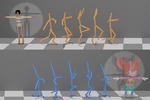Short Bio
My name is Peizhuo Li (李沛卓). I am a direct doctorate student at Interactive Geometry Lab under the supervision of Prof. Olga Sorkine-Hornung. My research lies at the intersection of deep learning and computer graphics, with an emphasis on modeling, control, and generative models for character animation, as well as related problems in geometry and physics. Prior to my PhD study, I was a student researcher at Visual Computing and Learning lab at Peking University and advised by Prof. Baoquan Chen.
Interests
- Computer Graphics
- Character Animation
- Deep Learning
Education
-
Direct Doctorate, 2021 ~ Present
ETH Zurich
-
BSc in Computer Science, 2017 ~ 2021
Turing Class, Peking University







